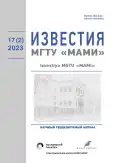Method for selecting the damping characteristics of the pneumohydraulic suspension system of a wheeled vehicle
- Authors: Sarach E.B.1, Krokhin M.E.1, Lychagov A.A.2, Smirnov I.A.1, Kositsyn B.B.1
-
Affiliations:
- Bauman Moscow State Technical University
- Kamaz
- Issue: Vol 17, No 2 (2023)
- Pages: 147-156
- Section: Hydraulic and pneumatic systems
- URL: https://journals.rcsi.science/2074-0530/article/view/253971
- DOI: https://doi.org/10.17816/2074-0530-192488
- ID: 253971
Cite item
Full Text
Abstract
BACKGROUND: In the process of developing suspension systems for modern high-speed wheeled and tracked vehicles, having the selected optimal elastic characteristic curve of the suspension system, its unsatisfactory damping characteristic curve can have a significant negative impact on the overall operation of the suspension unit. Therefore, the search for a method for obtaining the optimal damping characteristic curve is a relevant task.
AIMS: Description the method for selecting the damping characteristic curve of a single-level pneumohydraulic spring for a wheeled vehicle considering the motion along tracks with a harmonic profile and a rough cobblestone road.
METHODS: The damping characteristic curve of the spring is selected using simulation mathematical modeling in the MATLAB/Simulink software, which makes it possible to take into account the nonlinearity of the suspension characteristics. In the process of building the characteristic curve, the limit values of the forces at the front wheels tires are fixed for the sections of the characteristic curve that operate with the valves of the pneumohydraulic spring turned off. Accelerations at the driver's seat and the pressure in the spring chamber are fixed for the sections of the characteristic curve that operate with the valves are turned on.
RESULTS: The results of the selection of an optimized damping characteristic curve showed an improved contact of the wheels with the surface and an increase in the stability of the vehicle, a decrease in vibration accelerations at low disturbance frequencies.
CONCLUSIONS: The practical value of the study lies in the possibility of using this method to develop suspension systems for new wheeled and tracked vehicles.
Full Text
##article.viewOnOriginalSite##About the authors
Evgeny B. Sarach
Bauman Moscow State Technical University
Email: sarach@yandex.ru
ORCID iD: 0000-0001-7027-9164
SPIN-code: 9645-5996
2nd Category Design Engineer of the Chassis Department
Russian Federation, 5 bldg. 1, 2nd Baumanskaya street, 105005 MoscowMaxim E. Krokhin
Bauman Moscow State Technical University
Author for correspondence.
Email: bodrov.serezha2018@yandex.ru
ORCID iD: 0009-0007-5406-5845
SPIN-code: 7887-1983
Associate Professor, Dr. Sci. (Tech.), Professor of the of the Multipurpose Tracked Vehicles and Mobile Robots Department
Russian Federation, 5 bldg. 1, 2nd Baumanskaya street, 105005 MoscowAlexander A. Lychagov
Kamaz
Email: alexts@bmstu.ru
ORCID iD: 0009-0009-1559-9590
Chief Designer for Automotive Units
Russian Federation, Naberezhnye ChelnyIlya A. Smirnov
Bauman Moscow State Technical University
Email: kkcc@bk.ru
ORCID iD: 0009-0000-3473-5660
Cand. Sci. (Tech.), Professor
Russian Federation, 5 bldg. 1, 2nd Baumanskaya street, 105005 MoscowBoris B. Kositsyn
Bauman Moscow State Technical University
Email: kositsyn_b@bmstu.ru
ORCID iD: 0000-0002-2131-2738
SPIN-code: 2005-7528
Associate Professor, Dr. Sci. (Tech.), Professor of the of the Multipurpose Tracked Vehicles and Mobile Robots Department
Russian Federation, 5 bldg. 1, 2nd Baumanskaya street, 105005 MoscowReferences
- Sarach EB, Tsipilev AA, Lychagov AA. Design of pneumohydraulic suspension systems for advanced military tracked vehicles. Izvestiya MGTU «MAMI». 2019;2(40):67–79. doi: 10.31992/2074-0530-2019-40-2-67-79
- Baibakov OV, Bashta TM, Kirillovsky YuL, et al. Hydraulics, hydraulic machines and hydraulic drives. Textbook for engineering universities. Moscow: Mashinostroenie; 1982.
- Idelchik IE. Handbook of Hydraulic Resistance. New York: CRC Begell House; 1994.
- Dmitriev AA, Chobitok VA, Tel'minov AV. Theory and calculation of non-linear suspension systems for tracked vehicles. Moscow: Mashinostroenie; 1976.
- Sarach EB. Metod vybora kharakteristik sistemy podressorivaniya s netselym chislom stepeney svobody dlya bystrokhodnoy gusenichnoy mashiny [dissertation]. Moscow; 2003.
- Smirnov A.A. Matematicheskoe modelirovanie pnevmogidravlicheskikh ustroystv sistem podressorivaniya transportnykh sredstv [dissertation]. Moscow, 1999.
Supplementary files




























